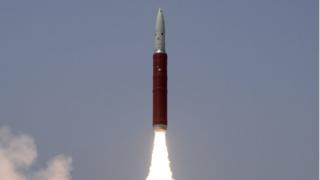 Image copyright
Image copyright
EPA
India is the fourth country to have carried out an ASAT test
Nasa has called India’s destruction of a satellite a “terrible thing” that could threaten the International Space Station (ISS).
The space agency’s chief, Jim Bridenstine, said that the risk of debris colliding with the ISS had risen by 44% over 10 days due to the test.
However he said: “The international space station is still safe. If we need to manoeuvre it we will.”
India is the fourth country to have carried out such a test.
Prime Minister Narendra Modi announced the test – Mission Shakti – with great fanfare on 27 March, saying it had established India as a “space power”.
In an address to employees, Mr Bridenstine sharply criticised the testing of such anti-satellite (ASAT) weapons.
He said that Nasa had identified 400 pieces of orbital debris and was tracking 60 pieces larger than 10cm in diameter. Twenty-four of those pieces pose a potential risk to the ISS, he said.
- Mission Shakti: Space debris warning after India destroys satellite
- US to set up new military ‘space force’
“That is a terrible, terrible thing to create an event that sends debris in an apogee that goes above the International Space Station. And that kind of activity is not compatible with the future of human spaceflight that we need to see have happen.”
A day after India successfully carried out its ASAT test, acting US defence secretary Patrick Shanahan warned that the event could create a “mess” in space but said Washington was still studying the impact.
Delhi has insisted it carried out the test in low-earth orbit, at an altitude of 300km (186 miles), to not leave space debris that could collide with the ISS or satellites.

“That’s why we did it at lower altitude, it will vanish in no time,” G Satheesh Reddy, the chief of India’s Defence Research and Development Organisation, told Reuters in an interview last week.
Mr Bridenstine said that it was true that this would eventually happen. “The good thing is, it’s low enough in Earth orbit that over time this will all dissipate,” he said.
China provoked international alarm with a similar test in 2007. The Nasa chief said “a lot” of the debris created by that test remained in orbit. The US military is in total tracking about 10,000 pieces of space debris, nearly a third of which is said to have been created by the Chinese test.
Arms control advocates have expressed concern about the increasing militarisation of space. ASAT technology would allow India to take out the satellites of enemy powers in any conflict, and the test is likely to fuel the growing regional rivalry between India and China.
The announcement also angered opposition parties in India, who have accused Mr Modi of using the test as a political stunt ahead of a general election. Indians will begin voting in national elections on 11 April.
Nasa: India’s satellite destruction could endanger ISS}

